During the flurry of October, between hauling in squashes, picking apples, making jam, planting garlic, and dumping wheelbarrows of mulch around the garden, I basically tossed anything that might be damaged by frost into the greenhouse, including my collections of Andean tubers and American groundnuts, assorted herbs, shrub cuttings, a few flowers, and tree starts – basically anything I didn’t want frozen solid in a pot. Also several containers of potting soil that I didn’t want saturated with oncoming rains. It was a lot.
The greenhouse, however, was still full of summer plants. The passion vines, tomatoes, ashwagandha, and a couple of volunteer mashua vines, in particular, had firmly established their dominance in their respective corners. And then there were basils, lemon verbena, Thai eggplant, and an assortment of cacti, more cuttings, and pots of seeds still hoping to germinate (or so I thought). Shelves and walkways were soon crowded.

Ok – truth be told – it was utterly impossible to even get in there, much less walk around.
It is interesting how no matter how large the space, I can manage to fill it. I mean, why do I even have all these cacti? They are an interesting plant. Some might even have psychotropic properties. They are impractical, but I can’t just throw them out in the cold. And seriously, Spider Plants? They seemed to add a tropical touch at the time. They were dying in the house, where I never remembered to water them. True, the 14’x16’ Solexx-covered mansion was a big step up from the 2’x2’ thing that used to blow over in a strong wind and take my seedlings with it – but I was now seriously questioning whether the upscale version might have shrunk in all that summer heat.
Clearly, some greenhouse organization was in order
Lesson: The greenhouse is always in a state of transition, so the key to greenhouse management – whether large or small – is in anticipating these changes and organizing and preparing accordingly. [Duh.] ~by Yours Truly
Greenhouse Organization Strategy:
- Prioritize Accessibility
- Remove anything that doesn’t need to be there
- Organize according to water needs and winter protection requirements
- Use the upper space! Install more shelves; hang plants where possible.
Winterization Strategy:
- Seal up cracks around windows and where rafters meet walls
- Mulch as much as possible
- Build framework around most sensitive plants that can be covered with an additional layer of plastic to create a greenhouse within a greenhouse
Step 1: Take an Inventory So You Know What You’re Up Against. Organize by Categories:
- Plants that should come indoors
- Overwintering tubers
- Frost-sensitive herbs and other plants that need extra protection
- Cuttings that appreciate humidity (an extra layer of plastic is helpful)
- Plants that like it more wet
- Plants that can tolerate cold, but prefer more dryness
- Cold-tolerant trees and shrubs in pots
- Cold-tolerant herbs
- Seeds that need some cold to germinate
- Plants that can be hung from rafters or poles
Realization: Categorizing the plants revealed I had over 30 pots of Andean tubers, over a dozen oak trees sprouted from acorns, 10 quince started from seed, and a good 2 dozen assorted herbs. Most of the plants are fairly cold hardy; they just need a little extra protection until they get bigger. Also, many of the herbs would survive fine in the ground outside, but I like being able to move them into the greenhouse in winter where they can still be harvested.
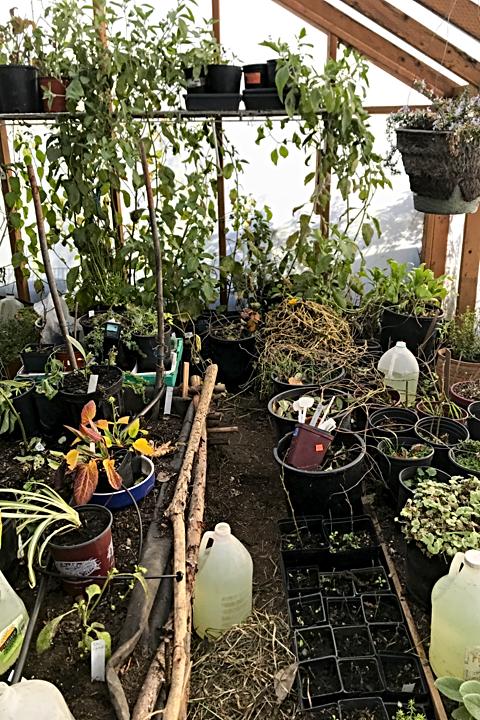
Step 2: Remove the Unnecessary:
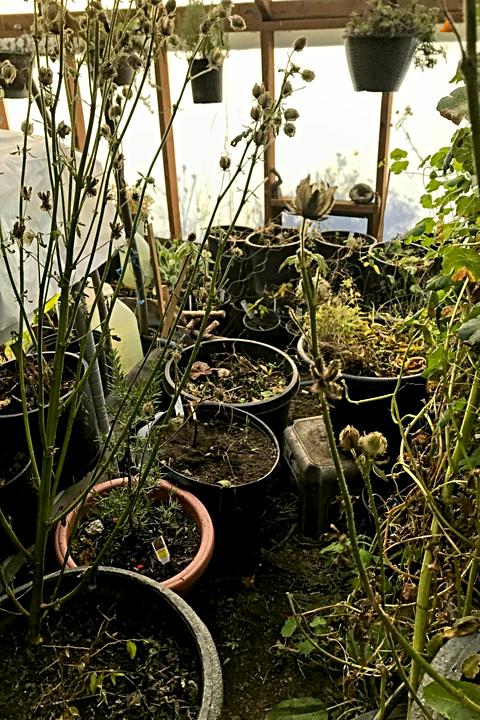
- Plants that won’t survive an unheated greenhouse: move into the house (spider plants and cacti – out you go)
- Annuals that are near the end anyway (I’m looking at you, whitefly-infested tomatoes; also, annuals, such as the beautiful kenaf that is still producing seeds, or those that are unlikely to produce at this point, such as the Thai eggplant)
- Plants that should be outside, for example, a rather large volunteer Lamb’s Ear plant growing in the main bed. It is quite beautiful but it is taking up valuable space and can survive fine in the great outdoors.
- Dead plants – what do I think is going to happen, are they going to come back to life like Lazarus? They need to be taken out. Admit defeat and Move On!
- Vines (passion flower, mashua, ashwagandha) – cut these back. Have faith. They will return in the spring.
- Large containers of extra potting soil – ok, I originally needed to get them out of the rain, but 10 buckets and large pots (I counted them) – whether starting mix, sand, peat, compost, used-but-still-good, whatever — is ridiculous.
- Soil amendments and fertilizers (as above, can be stored elsewhere)
- Trays of ungerminated seeds and leafless cuttings: if they haven’t rooted by now, they probably won’t (I hate to give up on anyone)
- Empty pots, trays, saucers
- Extra watering containers and sprayers that won’t be needed over winter
- Extra tools
- Shade cloth hung up for the shade-lovers: not only unnecessary, but also tacky. The passion vine growing in front of this area provided plenty of shade; and even shade lovers appreciate a little light.
- Assorted Riff-Raff. You know who you are. Out.
Winterization Tasks:
- Tape up all cracks around windows with duct tape; insert foam strips in gaps where roof meets south wall.
- Mulch everything with leaves, straw, sawdust, etc.
- Fill up any empty water jugs so they can warm up during the day and help plants get through the night. Strategically place some closer to the plants they can protect (and perhaps water the soil). Remove any on shelves that leak.
- Build a framework of willow to create a greenhouse within a greenhouse over selected areas. Temps in our area can get down to 10 degrees F, although rarely and usually not for long. I do not heat the greenhouse with electricity. Alternative heating methods might be considered for future years.
- Wipe down the walls to let in as much light as possible on these short winter days. Solexx is easy to clean with a little soap and water.
Issues and Observations:
The Marie Kondo Approach: What sparks joy here? The “removing stuff” task is not always about letting go or admitting failure; it is also about evaluating what works – or not. It’s about efficiency, cleaning out, and making things look more tidy – and making room for artistic expression (which brings joy!) However, Marie Kondo, I am not. I have a very difficult time throwing things away. I hate waste (and especially adding to landfills). What is taken out still needs to go somewhere – so sometimes the simple task of removal turns into a larger task of cleaning out or creating another area in which to store something, which might lead to doing the same somewhere else, and so on. If I stick with it, the whole place will eventually be organized and then I can start over. Or – just stop – come to terms with the fact that you have too much stuff. “You” meaning me, of course.
Tomato Vines: I cut out the tomatoes in stages to give some of the final cherry tomatoes a chance to sweeten up, but the great majority of them were now destined for the compost. We were really tomato-saturated this year. The plants, although productive, were dense and caused a lot of problems, which I will write about in a future post. I will need to learn to be more ruthless in the future. When they first come on, they are such an exotic treat; but for now, I am so done with tomatoes.
Mashua Vines: These were a surprise, growing up from beneath a large pot. I am thankful, because I thought I had lost my entire crop except for a few bulbs in pots. The vines grew quite tall, up and over the shelves on the east wall and up to the ceiling – and now they were blooming! Beautiful bright orange sweet little honeysuckle-like blooms, and I so wish the hummingbirds could find them! Clearly, these needed a designated space in which they could thrive. I removed the pot that was crushing them, harvested a large bowl full of roots, and then built a bed around the remaining plants. So much better.
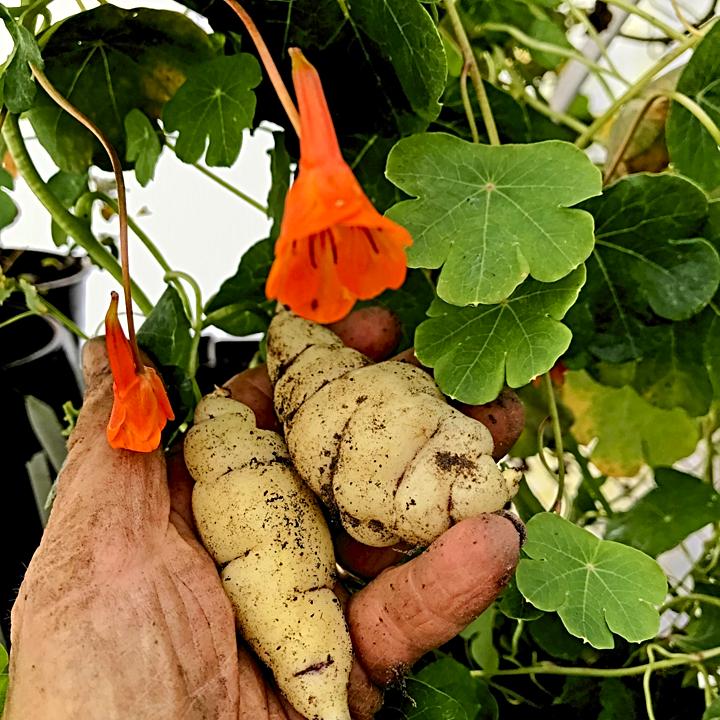
Mobility Issues: Not everything can be moved around. Configuring the greenhouse to accommodate both potted and in-the-ground plants has always been a bit of a dilemma for me. My plants do best where they can spread out their roots, take advantage of microbial communities, and escape my tendency to overwater everything; however, a whole lot of the greenhouse is filled with potted plants that are always coming and going, depending on the season. These are seedlings, cuttings, and plants that need protection either from cold or small mammals. Speaking of,
Rodents: Lo and behold, when I wasn’t looking, a rather large rat built a nest above head high in the passion vines. I saw the vines quiver slightly when I walked in one day, and suddenly there she was, staring at me. She scrambled up to the top of the rafters and stayed very still. I don’t blame her for seeking out a warm place for winter, but raising a family here was unacceptable, and we undoubtedly both highly valued the passion fruits, Andean tubers, and saffron bulbs, which I quickly covered with metal screens. She would have to go.
I cut back some of the passion vines (the vines die back with the cooler weather, anyway), not disturbing the nest, and gave her a chance to leave. I cut back a few more the next day, and then even more the next. I harvested numerous fruits in the process (We have plenty of seeds!) These are the Maypop variety, which are hardier than the tropical fruit variety. They might be able to survive outside, but the wall of vines and abundant flowers in the greenhouse have been spectacularly exotic. The rat did not like all the commotion and left on her own accord. Maybe it ws my singing?
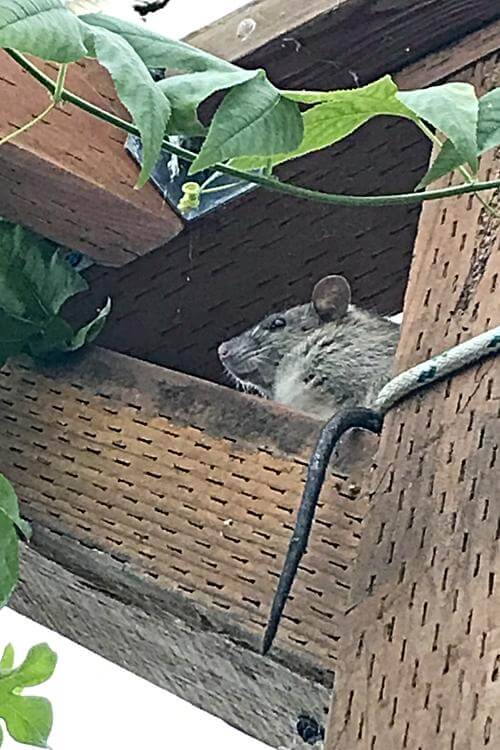
The rat waited for me to leave at the very top beam of the greenhouse. This critter will easily wipe out all my Andean roots and saffron bulbs. I am sympathetic, but she has to leave.
Spectacular Discovery!
My ramps have sprouted in the plastic bags that I stashed in there over a year ago. I cannot believe it! Previously, a single seed germinated, which I carefully transplanted. The next day, I came out to see it beginning a growth spurt only to find its head had been bitten off, probably by a roly poly pillbug or slug. There aren’t many of those around at this time of year (I am keeping an eye out for slugs, though). Just goes to show – don’t give up on some of the slow germinators!
Conclusion:
Success! I am amazed I can walk in here! Everything is organized to where I can access what we need and move things out when the temps warm up in early spring. I could probably start a small salad garden (certainly some microgreens!) and I even have shelf space for adding trays of seeds! Longer days are just around the corner. And when the weather outside is frightful, the greenhouse is my favorite place to get my gardening fix. It was in the 50s in there in late-December. That’s almost balmy!
Greenhouse Inventory (14’x16′ building w/~10’x16′ growing space):

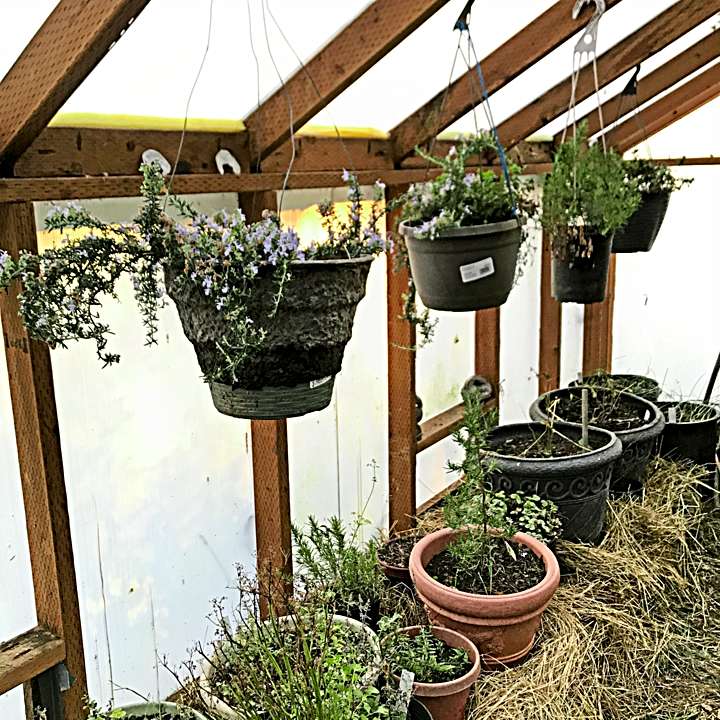
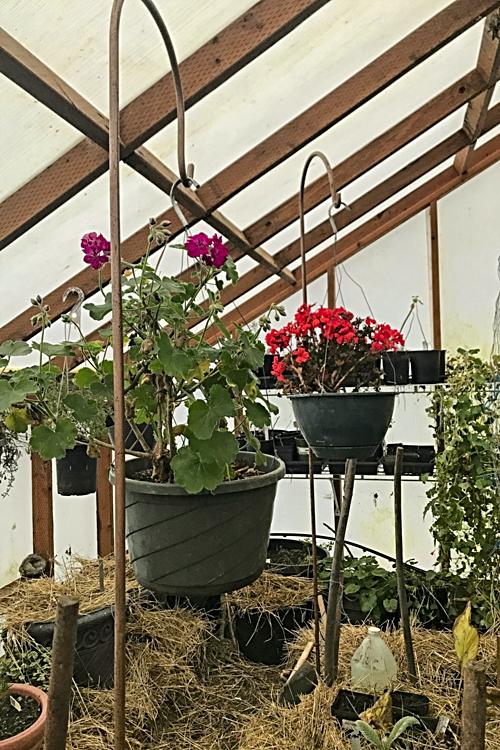
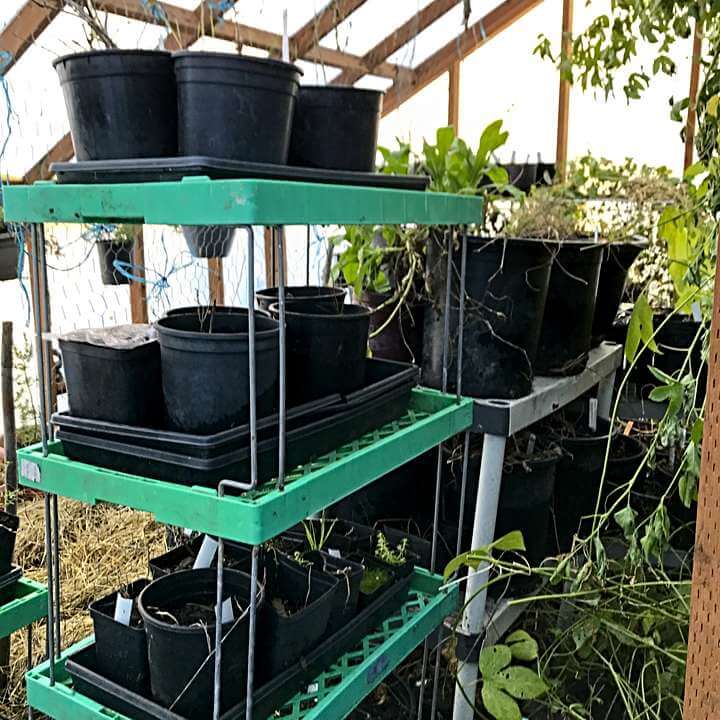
Trees & Shrubs:
- Blueberry: 1
- Bush clover: 4
- Ceanothus: 1
- Corkscrew hazel cuttings: 3
- Elder: 3
- Green myrtle: 1
- Jujube: 3
- Lavender: 2
- Linden tree: 4
- Loquat: 2
- Oak: 17
- Paw paw: 2
- Quince: 7
- Seaberry: 1
- Siberian pea 30, maybe more
- Yellowhorn: 3
Fruiting Vines / berries
- Black Raspberry: 1
- Kiwi: 5
- Lingonberry: 3
- Passion vines: numerous in the ground
- Red flowering currants: 3
- Thornless boysenberry: 1
Tubers
- American ground nuts: 20
- Chinese Yam: 3
- Mashua: 4
- Oca: 1
- Skirret: 2
- Ulluco: 13
Herbs & plants that don’t need heavy protection:
- Bergamot: 1
- Calendula: 1
- Catmint: 2
- Celery herb: 3
- Cranberries: 6
- Garlic chives: 8
- Grindela: 2
- Mentuccia oregano:3
- Oregano: 2
- Pennyroyal: 2
- Rosemary: 6
- Tarragon: 2
- Thyme: 10
Fairly Hardy:
- Saffron: 3
- Sedums: 2
- Sedums: Hens & Chicks: 1
Flowers & Needing Some Protection
- Artichoke: 2
- Geraniums: 4
- Lemon Verbena: several in ground
- Miscellaneous potted flowers: 3
- Rudbeckia: 2
- Spider plant: 2
Need More Protection
- Ashwagandha in the ground: many plants
- Curry plant: 1
- Eggplant: 1
- Ginger: at least 6
- Holy Basil: 3 (almost done)
- Licorice: 5
- Turmeric: at least 5
- Wasabi: 2
Also:
- Unknown: 3 possibly Yellowhorn or Siberian pea
- 3 seed trays that may or may not eventually sprout; everything from Quamash to marshmallows
- 1 tray of seeds that require a period of cold to germinate
Currently blooming:
- Calendula
- Geraniums
- Mashua
- Rosemary
- Rudbeckia
Making seed in November:
- Ashwagandha
- Kenaf
- Passionfruit
Plants Moved into the House
- Australian mint
- Green Tea Plant
- Large Christmas cactus
- San Pedro cacti and other small cacti
- Some geraniums (some left)
- Spider plants
- Stevia
- Tea tree plant
OUTSIDE: in pots:
- Linden tree: 1
- Azalea: 1
- Osage Orange: 1
- Kiwiberries 2
- Sea kale: 2
- Blue elder: 4
- Pink willow: 1
- Seaberry: 2
- Parsley: 1
You might also like:
- Winter Greenhouse Gardening: Strategies for Survival in an Unheated Space
- Solexx Greenhouse Kits and Materials
- 2018 Highlights; 2019 Goals, Strategies, and New Beginnings
Blythe, good to hear you are doing well! I missed this blogpost somehow, they are always so interesting! The photo of the buck deer at your bird feeders is a classic! Our deer clean up apples and the branches our apple trees that are not fenced. But they haven’t the courage to come to the bird feeders…..yet. I am trying to supress the spring fever. But today I did dig around in my garden shed until i found the pots with mini iris bulbs. The poor things were not only sprouted, but lanky and long with purple flowers already! I brought them up to the porch and gave them an apologetic conversation along with some water. My garlic are all doing quite well. Thank you for your posts, stay healthy!
Hi Beth! Good to hear from you again! I am visualizing you apologizing to your gangly irises (blooming already! brave souls!) Haha! That’s how I felt when I found the mashua roots. Yes, the deer here are brazen. I wave my arms about and they just stare at me. They clean all the leaves off the lower branches of the apple trees. We still get plenty of apples, though. I figure a lot of people would give anything to see deer meandering around their backyards, so I’ve decided we can all share the landscape. I give them a smorgasbord in a safe place. LOL. You stay healthy, too! Spring is just a month away!